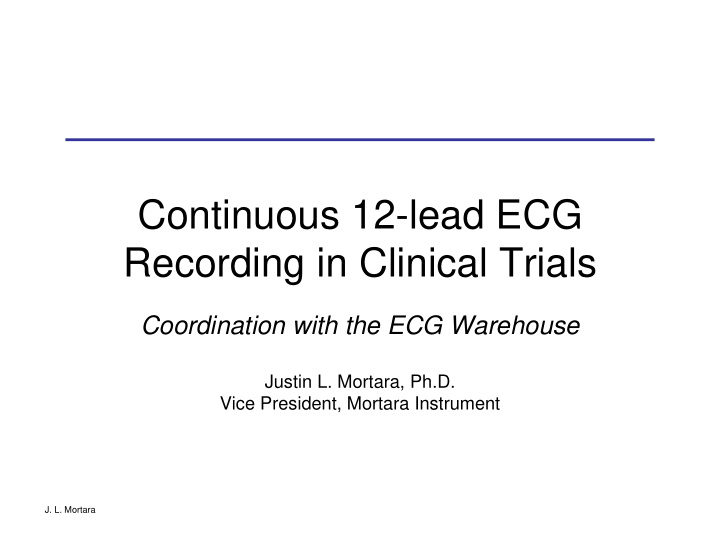



Continuous 12-lead ECG Recording in Clinical Trials Coordination with the ECG Warehouse Justin L. Mortara, Ph.D. Vice President, Mortara Instrument J. L. Mortara
Continuous 12-lead Recording 12-lead 12-lead Telemetry Holter 24, 48, 72+ hours of data 12-leads ≅ 0.5 GB/day/subject @ 1000 samples/second J. L. Mortara
Uses in Clinical Trials Today • Snapshots extracted for interval duration measurement (e.g. QT). – Continuous recording simplifies collection of many 12-lead ECG time points in so-called thorough-QT (TQT) trials. – Record everything, extract individual time points afterward for measurement. DOSE, T = 0 ECG Time Point • NDA submission includes TQT trial. – Extracted ECGs from TQT trial uploaded to ECG Warehouse. – FDA can review ECG waveforms and annotations once loaded into Warehouse. J. L. Mortara
ECG Warehouse • Motivation for ECG Warehouse – Facilitate regulatory review of ECG studies. – Enable research into alternate repolarization measures using rich digital data repository. • Status Today – Over 150 Studies accessible for FDA review – Nearly 2 million ECGs and quickly growing….this is fastest growing digital ECG repository in the world. – CSRC is developing mechanisms for select data from this repository to be used for research purposes. Accumulated ECG snapshots J. L. Mortara
More with Continuous Records • Expanded potential H1 for regulatory review – Not just reviewing the extracted ECG and Flattening of T-wave from hour 1 to hour 3. annotations, but also H2 reviewing time before and after. – Excellent for What is happening in between these extractions? understanding evolution of H3 morphology changes. J. L. Mortara
More with Continuous Records • Improve QTc determination. 440 – Historical approach is to use prior RR in QT normalization. 430 QT (ms) – Utilize continuous record for bin-method (method of 420 Coumel) or alternate QT vs Previous RR determination of RR (RRc 410 pictured at right) 700 800 900 1000 1100 1200 1300 1400 RR (ms) • Reduce variability, reduce need for additional subjects, 440 reduce cost of study. 430 – Cannot be achieved with QT (ms) simple snapshot ECGs. 420 QT vs RRc 410 700 800 900 1000 1100 1200 1300 1400 RR (ms) J. L. Mortara
More with Continuous Records • Apply automatic algorithms to entire continuous recording. – Increase statistical power by making the ECG algorithm do “all” the work. – Detection of positive control well reproduced using these methods. • In a 24 hour recording there are over 8,600, 10-second snapshot ECGs to be analyzed and typically over 100,000 beats to be annotated. – Excellent venue for algorithm automation. – If this becomes common, what should be submitted to ECG Warehouse? J. L. Mortara
Conclusions • Use of continuous recordings is already widespread. • Much more can yet be done to leverage the continuous aspect of the recorded data. • Creating a warehouse of continuous recordings can further both regulatory and research possibilities. J. L. Mortara
Recommend
More recommend